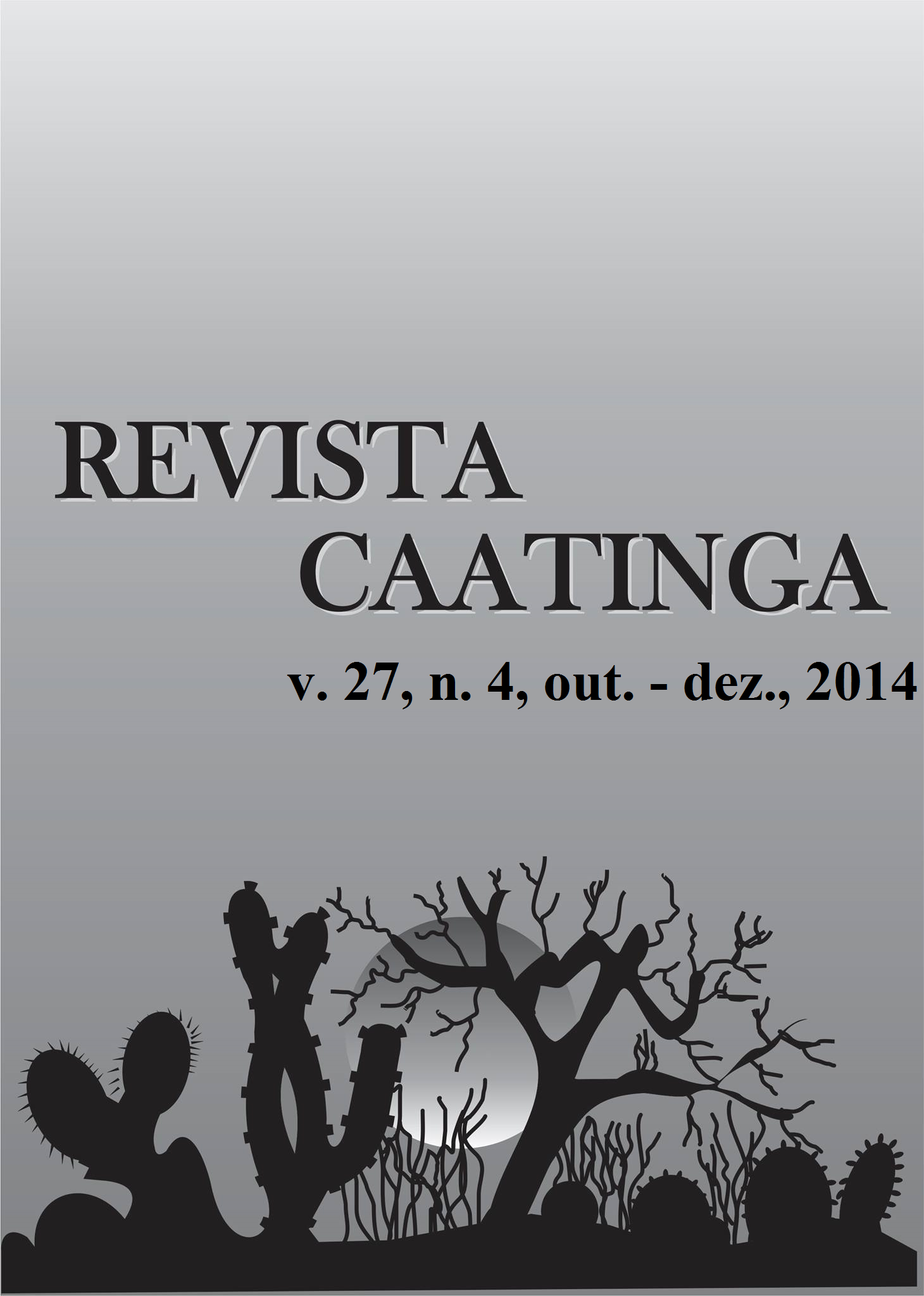EXTRACTION AND CHARACTERIZATION OF FATTY ACIDS IN CARNAÚBA SEED OIL
Palavras-chave:
Copernicia prunifera. Vegetable oil. Fatty acids. Gas Chromatography.Resumo
This paper describes the composition of fatty acids in oil extracted from seeds of carnaúba (Copernicia prunifera (Miller) H. E. Moore), an important palm species native to Northeastern Brazil. After extracting the crude oil, the physico-chemical characteristics (density, refraction index, pH, acidity and saponification index) were registered and the chemical composition of the fatty acids was determined by gas chromatography (GC-FID). The predominance of saturated fatty acids does not make carnaúba seed oil a promising alternative for the food industry, and the small yield obtained (approx. 5%) may constitute a limiting factor for commercial exploitation, but carnauba seed oil could potentially be used in the production of biofuels, cosmetics and detergents.Downloads
Referências
ARAGÃO FILHO, J. E. L; ARAGÃO, N. S. Cadeia produtiva da carnaúba. Dossiêtécnico. Salvador: Instituto Evaldo Lodi-BA, 2013. 20 p.
ARAÚJO, J. M. A. Química de alimentos: Teoria e prática. 5. ed. Viçosa: UFV, 2011. 601 p.
BOEING, H. et al. Critical review: vegetables and fruit in the prevention of chronic diseases. European Journal of Nutrition, Bonn, v. 51, n. 6, p. 637-663, 2012.
BRASIL. Regulamento técnico para óleos vegetais e gorduras vegetais e creme vegetal. Resolução RDC nº 271, de 22 de setembro de 2005. Brasil. 2005.
CARVALHO, F. P. A; GOMES, J. M. A. Eco-eficiência na produção de cera de carnaúba no município de Campo Maior, Piauí, 2004. Revista de Economia e Sociologia Rural, Brasília, v. 46, n. 2, p. 421-453, 2008.
CODEX. Codex standard for named vegetable oils: cx - stan -1999. Codex Alimentarius, Roma, v. 8, p. 11-25, 2001.
FERREIRA, C. S.; NUNES, J. A. R.; GOMES, R. L. F. Manejo de corte das folhas de Copernicia prunifera (Miller) H. E. Moore no Piauí. Revista Caatinga, Mossoró, v. 26, n. 2, p. 25-30, 2013.
GUNSTONE, F. D. Vegetable oils in food technology: composition, properties and uses. 1ª edition. UK, London: Blackwell Publishing, 2002. 352 p. ISBN 1-84127-331-7
KHAN, A. I. A GC-FID method for the comparison of acid-and base-catalyzed derivation of fatty acids to fames in three edible oils. Thermo Scientific, applic. note 20733, UK, 2013.
LORENZI, H.; SOUZA, H. M.; MEDEIROS-COSTA, J. T. DE. Palmeiras do Brasil: nativas e exóticas. Nova Odessa: Plantarum, 1996. 306 p.
LUBBE, A.; VERPOORTE, R. Cultivation of medicinal and aromatic plants for specialty industrial materials (Review). Industrial Crops and Products, Philadelphia, v. 34, n. 1, p. 785- 801, 2011.
MANN, J. et al. Natural products: their chemistry and biological significance. 1ª ed. Harlow, Essex, England: New York: Longman Scientific & Technical, 1994, 455 p.
MAPRIC. Óleo de babaçu. Disponível em: http:// http://www.mapric.com.br/anexos/boletim665_08092010_181915.pdf >. Acesso em 05 mar. 2014.
MELO, J. D. D. et al. A biodegradable composite material based on polyhydroxybutyrate (PHB) and carnauba fibers. Composites: Part B, Engineering, Amsterdam, v. 43, n. 7, p. 2827-2835, 2012.
MELO, M. A. R. et al. Study of the oxidative stability of oils vegetables for production of Biodiesel. Revista Verde de Agroecologia e Desenvolvimento Sustentável, Mossoró, v. 9, n. 1, p. 84-88, 2014.
MORO, M. F.; WESTERKAMP, C.; DE ARAÚJO, F.S. How much importance is given to native plants in cities’ treescape? A case study in Fortaleza, Brazil. Urban Forestry & Urban Greening, Philadelphia, v. 13, p. 365-374, 2014.
OLIVEIRA, V. B. et al. Native foods from Brazilian biodiversity as a source of bioactive compounds. Food Research International, Toronto, v. 48, n. 1, p. 170-179, 2012.
PEREIRA, D. S. et al. Emergence and initial growth of Copernicia prunifera (Arecaceae) as a function of fruit maturation. Journal of Seed Science, Londrina, v. 36, n. 1, p. 9-14, 2014.
REDA, S. Y.; CARNEIRO, P. I. B. Óleos e gorduras: aplicações e implicações. Revista Analytica, São Paulo, v. 27, n. 2, p. 60-67, 2007.
REIS, R. G. E. et al. Emergência e qualidade de mudas de Copernicia prunifera em função da embebição das sementes e sombreamento. Revista Caatinga, Mossoró, v. 24, n. 4, p. 43-49, 2011.
RUFINO, M. S. et al. Bioactive compounds and antioxidant capacities of 18 non-traditional tropical fruits from Brazil. Food Chemistry, Reading, v. 121, n. 4, p. 996-1002, 2010.
RUFINO, M. S. et al. Free radical scavenging behavior of ten exotic tropical fruits extracts. Food Research International, Philadelphia, v. 44, n. 7, p. 2072-2075, 2011.
SOUSA, C. M. M. et al. Fenóis totais e atividade antioxidante de cinco plantas medicinais. Química Nova, São Paulo, v. 30, n. 2, p. 351-355, 2007.
ZENEBON, O.; PASCUET, N. S.; TIGLEA, P. Métodos físico-químicos para análise de alimentos. 4. ed. (1ª Edição Digital). São Paulo: Instituto Adolfo Lutz, 2008. 1020 p.
Downloads
Publicado
Edição
Seção
Licença
Os Autores que publicam na Revista Caatinga concordam com os seguintes termos:
a) Os Autores mantêm os direitos autorais e concedem à revista o direito de primeira publicação, com o trabalho simultaneamente licenciado sob a Licença Creative Commons do tipo atribuição CC-BY, para todo o conteúdo do periódico, exceto onde estiver identificado, que permite o compartilhamento do trabalho com reconhecimento da autoria e publicação inicial nesta revista, sem fins comerciais.
b) Os Autores têm autorização para distribuição não-exclusiva da versão do trabalho publicada nesta revista (ex.: publicar em repositório institucional ou como capítulo de livro), com reconhecimento de autoria e publicação inicial nesta revista.
c) Os Autores têm permissão e são estimulados a publicar e distribuir seu trabalho online (ex.: em repositórios institucionais ou na sua página pessoal) a qualquer ponto antes ou durante o processo editorial, já que isso pode gerar alterações produtivas, bem como aumentar o impacto e a citação do trabalho publicado (Veja O Efeito do Acesso Livre).







